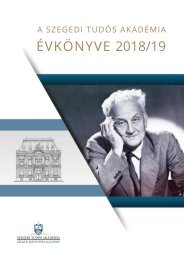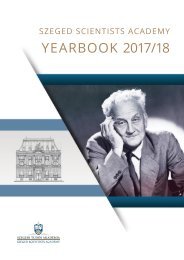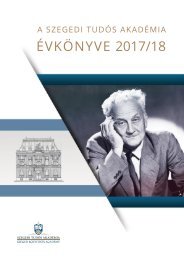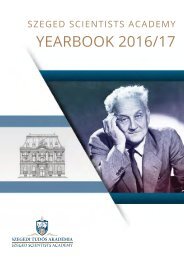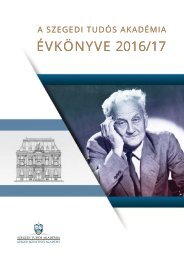You also want an ePaper? Increase the reach of your titles
YUMPU automatically turns print PDFs into web optimized ePapers that Google loves.
SZENT-GYÖRGYI JUNIOR MENTORS<br />
RENÁTA TÓTH<br />
University of Szeged,<br />
Department of Microbiology<br />
Address: Közép fasor 52., H-6726, Szeged, Hungary<br />
RESEARCH AREA<br />
Besides the bacterial flora, several fungal species are also<br />
long-term occupants of the oral microbiota. Among these,<br />
Candida are the most abundant species. Although the role<br />
of the human bacteriota and virome is well characterized,<br />
less is known about the composition of the mycobiota, let<br />
alone its role in the host. Therefore, one purpose of our<br />
project is to examine how do normal oral epithelial cells<br />
respond to the presence of commensal Candida species.<br />
We aim to explore their recognition, the corresponding<br />
signal transduction mechanisms and potential effector<br />
functions in the presence of various fungal stimuli. Since<br />
the last decade, numerous studies report alterations in the<br />
diversity of the oral microflora of immunocompromised and<br />
cancer patients (e.g. with oral squamous cell carcinoma),<br />
allowing the overgrowth of opportunistic pathogenic<br />
species (such as C. albicans and C. parapsilosis). Besides<br />
the increased probability of oral candidiasis in these<br />
patients, the abnormally altered microbiota might also<br />
influence the underlying diseases’ progression. In addition<br />
to investigating the immune response regulatory effect<br />
of normal oral epithelial cells, we further aim to examine<br />
the potentially altered immunomodulatory effects of oral<br />
squamous cell carcinoma cells and to explore signaling<br />
routes that might be associated with tumor progression<br />
following fungal stimuli.<br />
SELECTED PUBLICATIONS<br />
Toth, R., Nosek, J., Mora-Montes, H., Gabaldon, T., Bliss, J.M.,<br />
Nosanchuk J.D., Turner, S.A., Butler, G., Vagvolgyi, Cs., Gacser,<br />
A. (20<strong>19</strong>) The emergence of Candida parapsilosis: from<br />
genes to the bedside. Clin Microbiol Rev 32 (2) e00111-18.<br />
Toth, R., Cabral, V., Thuer, E., Bohner, F., Nemeth, T., Papp,<br />
Cs., Nimrichter, L., Molnar, G., Vagvolgyi, Cs., Gabaldon, T.,<br />
Nosanchuk, J.D., Gacser, A. (<strong>2018</strong>) Investigation of Candida<br />
parapsilosis virulence regulatory factors during hostpathogen<br />
interaction. Sci Rep 8(1):1346.<br />
Toth, R., Toth, A., Vagvolgyi, Cs., Gacser, A. (2017) Candida<br />
parapsilosis secreted lipase as an important virulence factor.<br />
Curr Protein Pept Sci. 18(10):1043-1049.<br />
Nagy, L.G., Toth, R., Kiss, E., Slot, J., Gacser, A., Kovacs, G.M.<br />
(2017) Six Key Traits of Fungi: Their evolutionary origins and<br />
genetic bases. Microbiol Spectr. 5(4).<br />
Toth, R., Toth, A., Papp, Cs., Jankovics, F., Vagvolgyi,<br />
Cs., Alonso, M.F., Bain, J.M., Erwig, L.P., Gacser, A. (2014)<br />
Kinetic studies of Candida parapsilosis phagocytosis<br />
by macrophages and detection of intracellular survival<br />
mechanisms. Front Microbiol. 5:633.<br />
TECHNIQUES AVAILABLE IN THE LAB<br />
Establishment/ optimization/ handling of in vitro coinfection<br />
models to examine fungal infections, using human<br />
monocytic, epithelial and murine cell lines and primary cells;<br />
phagocytosis and killing experiments; RNA preparation;<br />
real-time PCR; ELISA; flow cytometry; metabolic activity;<br />
cell adhesion and host cell killing (LDH) assays, live cell<br />
imaging. Next-generation sequencing, RNA-seq, micro RNA<br />
investigations.<br />
89






